- Tokyo Shibuya Koen-dori Gallery YouTube
- Tokyo Shibuya Koen-dori Gallery X
- Tokyo Shibuya Koen-dori Gallery instagram
- 白
- 青
- 黒
- Fontsize small
- Fontsize big
Art Brut Then and Now Vol.4
The Meeting Place of Unveiled Worlds

Exhibition Overview
Art Brut Then and Now is a series of exhibitions introducing, from various perspectives, artists who have been active in the domestic and international Art Brut movement for a long time, as well as those who have begun exhibiting on a wider basis in recent years. This, the fourth Art Brut Then & Now exhibition, is titled “The Meeting Place of Unveiled Worlds” and welcomes Jennifer Gilbert, a UK-based curator, producer, and gallerist in the field of Art Brut/Outsider Art, as guest curator. The exhibition is an opportunity to introduce 11 British artists of a wide range of generations, from long-known artists such as Madge Gill and Scottie Wilson, to up-and-coming artists who are exhibiting in Japan for the first time. We hope this exhibition will be a place for you to meet unveiled worlds.
“The Meeting Place of Unveiled Worlds” - Exhibition Documentation
| Title | Art Brut Then and Now Vol.4
The Meeting Place of Unveiled Worlds |
|---|---|
| Period | Saturday, 21 Jun – Sunday, 31 August 2025 |
| Opening Hours | 11:00AM - 7:00PM *Extended hours until 9:00PM on Fridays:15, 22, and 29 August |
| Closed | Mondays*, 22 July, 12 August *except 21 July, 11 August |
| Venue | Tokyo Shibuya Koen-dori Gallery, Gallery1,2 and Interactive Space |
| Admission | Free |
| Guest Curator | Jennifer Gilbert of Jennifer Lauren Gallery |
| Artists | Madge Gill, Andrew Johnstone, Nigel Kingsbury, Cara Macwilliam, Tirzah Mileham, Cameron Morgan, Jesse James Nagel, Valerie Potter, Cathy Ward, Terence Wilde, Scottie Wilson *Alphabetical order |
| Graphic Design | Art Direction MIKI Shun-ichi, Design HIROTA Moe (Bunkyo-Zuan-Shitsu) |
| Cooperation | Jennifer Lauren Gallery |
| Support | British Council |
| Organizer | Tokyo Shibuya Koen-dori Gallery, Museum of Contemporary Art Tokyo, Tokyo Metropolitan Foundation for History and Culture |

- Download Brochure
Guest Curator

Guest Curator Jennifer Gilbert
Jennifer Gilbert
Jennifer Gilbert is a UK-based gallerist, freelance producer, and curator, working internationally with disabled, neurodivergent, and self-taught artists since 2008. In 2017 she launched the Jennifer Lauren Gallery to showcase and empower overlooked artists, holding exhibitions in museums and galleries internationally, and taking part in art fairs. She organizes professional development pathways and holds mentoring sessions for disabled artists, alongside consultancy work with museums and organizations regarding access and inclusion.
Artists
Madge Gill(1882〜1961)
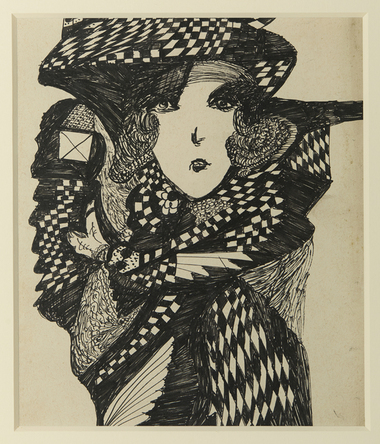
Madge Gill, Untitled, c.1945, Collection of Adam Whitaker, Photo by Laura Hutchinson
Madge Gill is recognised as Britain’s most famous female outsider artist. Her distinctive ink drawings, featuring mysterious female faces floating within intricately patterned backgrounds, began in 1920, driven by an instinctive compulsion to create. She believed she was guided by a spirit named ‘Myrninerest,’ resulting in a prolific outpouring of mediumistic art produced automatically. Gill worked on a range of mediums, from vast swathes of calico to postcards and pieces of cardboard.
Andrew Johnstone(1986〜)
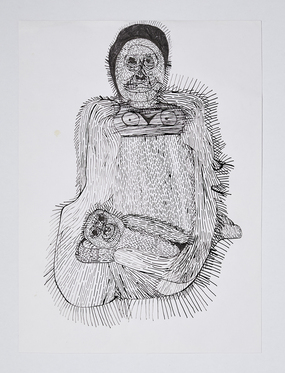
Andrew Johnstone, Untitled(Orangutan), 2020, Courtesy the artist and Venture Arts, Photo by Laura Hutchinson
Andrew Johnstone’s passion for drawing was nurtured from a very young age by his family. Drawing was also very important as it was a means by which the family communicated with Johnstone, for example by depicting people or places that they were going to visit. Johnstone works in a precise and deliberate way through drawing and ceramics. He often depicts animals and events, with a focus on things he has seen in-person or online.
Nigel Kingsbury(1949〜2016)
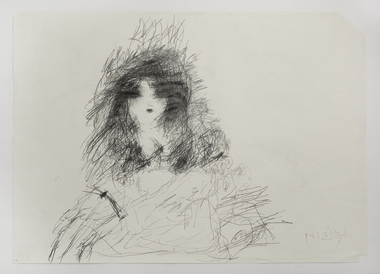
Nigel Kingsbury, Untitled, n.d., Courtesy of ActionSpace, Photo by Laura Hutchinson
Nigel Kingsbury had a fascination with the female form and, using his unique style of mark making, he produced fine, delicate portraits of women as mystical goddesses attired in glamorous ball gowns, decadent outfits, and floating dresses each possessing an almost ethereal quality. The initial figure would often be nude, and he would then add folds of fabric created using layers of finely sketched lines. His drawings were dedicated to the women who inspired him.
Cara Macwilliam(1972〜)
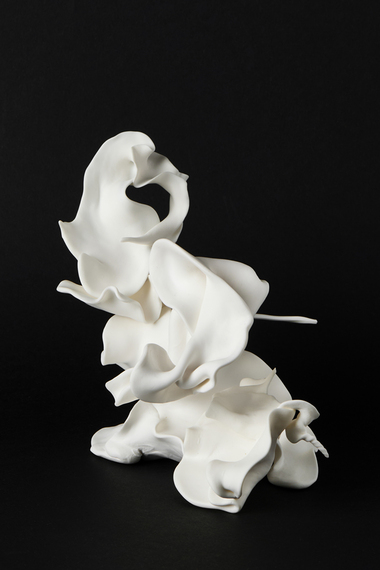
Cara Macwilliam, Fragmented Whispers of Instability, 2025, Courtesy the artist and Jennifer Lauren Gallery, Photo by Laura Hutchinson
Cara Macwilliam is a multi-disciplinary artist who is fascinated with energy; from the physical and emotional, to the metaphysical. Her pieces capture the marks of ephemeral entities, energies and the otherworldly. The different styles produced are led by the materials used, each one has a distinctive voice and flow. The works are often layered and intricate but always pulling from intuition and unseen forces. Automatism is her preferred process.
Tirzah Mileham (1971~)
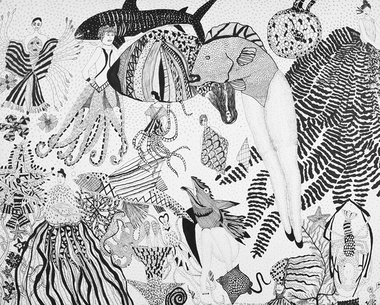
Tirzah Mileham, When Women and Fish Took Over the World, 2022, Courtesy the artist and submit to Love Studios
Tirzah Mileham has been a Submit to Love studio artist for the last twenty years and devotes many hours a week exploring her passion for the arts. Looking through her body of work you will find speckles of craft, splashes of colour but most recently her imagination runs wild with her monochromatic drawings filling every inch of her paper.
Cameron Morgan(1965〜)
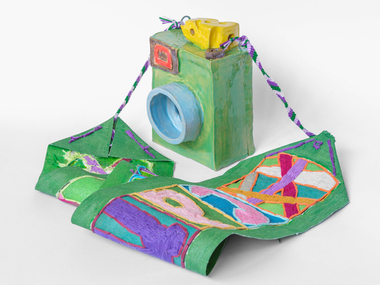
Cameron Morgan, Say Cheese, 2024, Courtesy the artist and Project Ability, Photo by Jack Wrigley
Cameron Morgan is a multi-talented and prolific artist working from the Project Ability studio in Glasgow since 1991. He works in bright 'poppy' colours across several disciplines including painting, ceramics, and embroidery. Drawing and particularly line is key in Morgan’s work. He will leave out the obvious, and accentuate parts over-looked, in doing so he is able to get to the essence of a subject. This series focuses on his love of the camera.
Jesse James Nagel(1993〜)
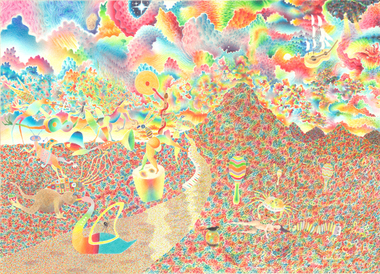
Jesse James Nagel, Every Gay Boy Detests Fanny, 2023, Courtesy the artist and Jennifer Lauren Gallery, Photo by Laura Hutchinson
London based Jesse James Nagel finds creating his art exhilarating – “Not like a relaxing chess game, it feels pretty action packed to me. I don't know what is going to happen.” He starts with unplanned pencil sketches and then he feels his hand just does the work, led by his subconscious, believing it would be ‘boring’ if he knew the final outcome. Nagel adds detail and colour as he goes along with the title evolving as the work progresses.
Valerie Potter(1954〜)

Valerie Potter, Untitled, 2020, Courtesy the artist and Jennifer Lauren Gallery, Photo by Ellie Walmsley
Although always creative, Margate based Valerie Potter, did not consider herself an art-maker. At 19, Potter enrolled at a UK art school, but found it restrictive and left, continuing her drawing at home. Her cross-stitch work often ties together faces, animals, plants, and love with non-religious gods. An abstract idea pops into Potter’s head (like a flower from the planet Mars), and after drawing it out in pencil, she takes her time cross-stitching it in wild bright colours.
Cathy Ward(1960〜)
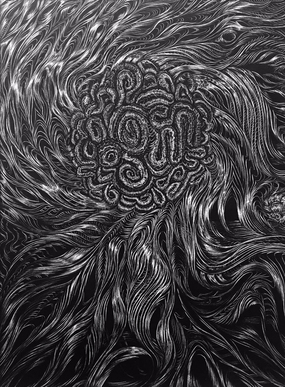
Cathy Ward, Unite, 2017-19,Courtesy the artist
Cathy Ward was sent, as a child, to a private convent run by the Irish order of The Sisters of Mercy. This experience had a profound and lasting effect on her and her work. After graduating from the RCA, a life changing spell in Canada was spiritually and creatively transformative, before returning to London. She is recognised for her intense ethereal drawings interpreted as hair, strata, and energy pulses.
Terence Wilde(1963〜)
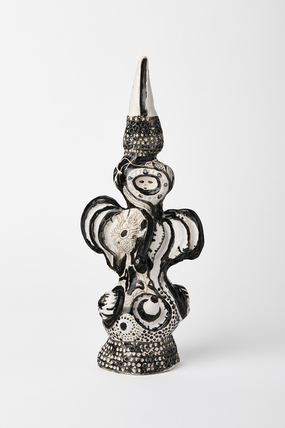
Terence Wilde, Orientation, 2025, Courtesy the artist and Jennifer Lauren Gallery, Photo by Laura Hutchinson
London based gay artist and educator Terence Wilde gained a degree in textiles but retrained through Croydon's voluntary mental health services. Wilde draws on his own mental health journey, from the perspective of an adult survivor, in all his black and white works. Working mainly in line drawing or ceramic, Wilde describes his works as responses to different periods in his life, showing struggles, fears, and dreams.
Scottie Wilson(1891〜1972)

Scottie Wilson, Masquerade, 1935, Collection of Adam Whitaker, Photo by Laura Hutchinson
Robert ‘Scottie’ Wilson emigrated to Toronto in 1931 from Glasgow. He started to draw during the 1930’s developing a very intense style ink drawing of dream-like creatures such as swans, birds, fish, trees and flowers. In early in 1945 he returned to London, and continued this practice, although he was quickly taken up by London’s Surrealists. Wilson relied on a relatively narrow range of visual elements – botanical forms, birds and animals, clowns (self-portraits), and ‘Greedies’ and ‘Evils’ (malignant personifications).
Text by Jennifer Gilbert
Related Events and Topics
■Guest curator’s Opening Talk (Language: English)
Date and Time: Saturday, 21 June, 2025 3:00 p.m. - 4:30 p.m.
The video recording of the talk event is available exclusively on YouTube during the exhibition period.
*Due to popular demand, the video has been re-released. (Updated Oct 17, 2025)
■Guest curator’s Opening Gallery Tour(Language: English)
Date and Time: Sunday, 22 June, 2025 2:00 p.m. - 3:00 p.m.
*The highlights video of the Gallery Tour is currently playing in the corridor at the exhibition venue.
■Reference Space
During the exhibition, the Interactive Space is open as a special area featuring materials related to ”The Meeting Place of Unveiled Worlds”.
In addition to the above, other related events are scheduled. Please check back for the latest updates.
Related Event
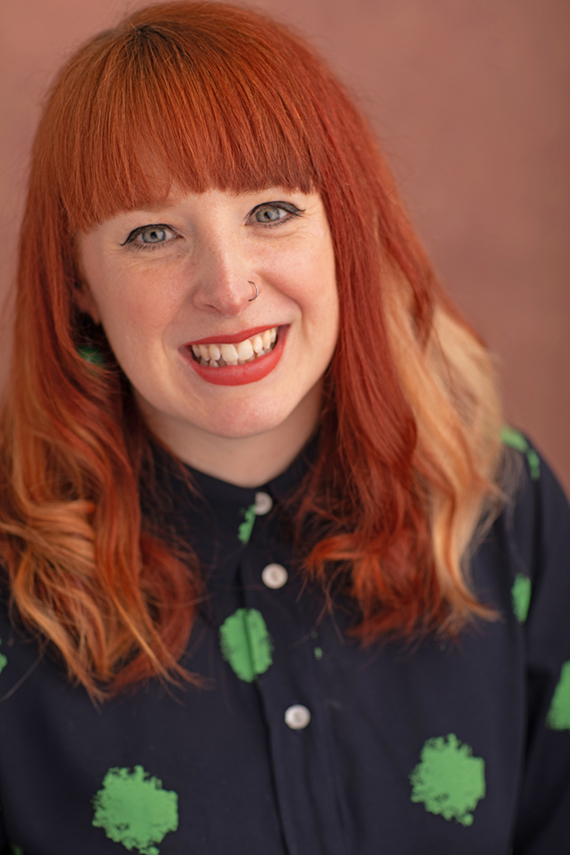
Related Event of "The Meeting Place of Unveiled Worlds"
Guest Curator's Opening Talk
- Period
- Saturday, 21 June, 2025 3:00 p.m. - 4:30 p.m.
- Venue
- Tokyo Shibuya Koen-dori Gallery
- Admission
- Free
Guest curators’ Talk (with Japanese and Japanese sign-language interpreting)
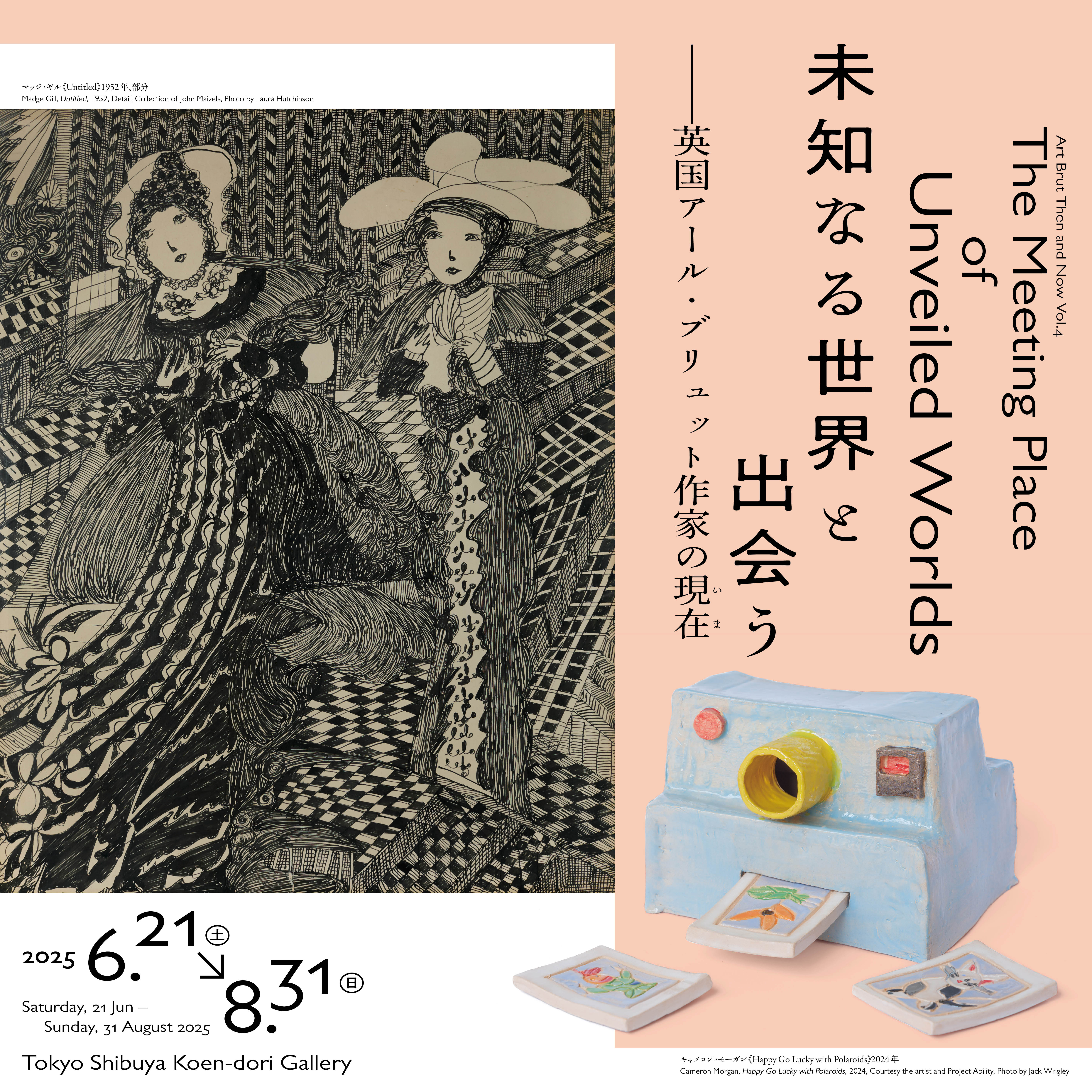
Related Event of "The Meeting Place of Unveiled Worlds"
Guest curator’s Gallery Tour
- Period
- Sunday, 22 June, 2025 2:00 p.m. - 3:00 p.m.
- Venue
- Tokyo Shibuya Koen-dori Gallery
- Admission
- Free
Guest curator's Gallery Tour (with Japanese and Japanese sign-language interpreting)
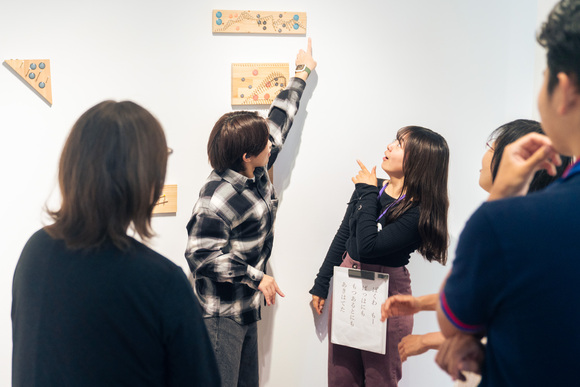
Related Event of "The Meeting Place of Unveiled Worlds"
"Shuwa-beri" Sign Language Chat and Art Viewing with supporters for accessibility
- Period
- Sunday, 10 August, 2025 2:00p.m. - 3:30p.m.
- Venue
- Tokyo Shibuya Koen-dori Gallery
- Admission
- Free
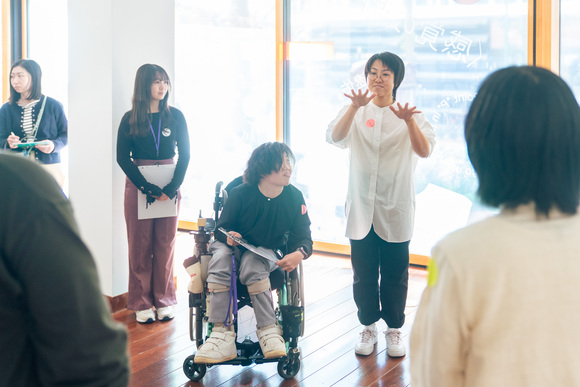
Related Event of "The Meeting Place of Unveiled Worlds"
Art Chat and Viewing with supporters for accessibility
- Period
- Monday(Holiday), 11 August, 2025 2:00p.m. - 3:00p.m.
- Venue
- Tokyo Shibuya Koen-dori Gallery
- Admission
- Free
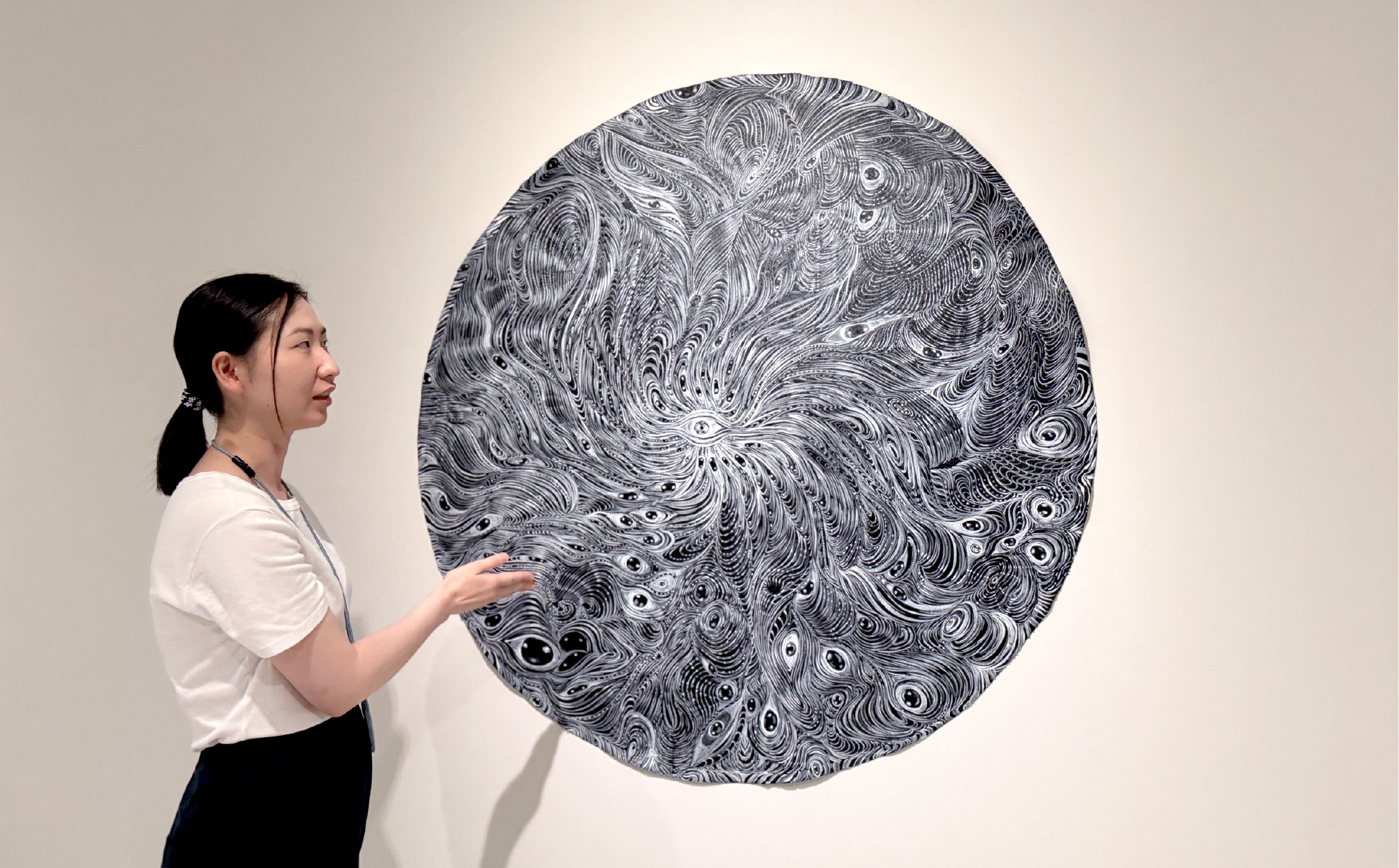
Related Event of "The Meeting Place of Unveiled Worlds"
Evening Art Chat &Viewing
- Period
- Friday, 22 August, 2025 7:30 p.m. - 8:30 p.m.
- Venue
- Tokyo Shibuya Koen-dori Gallery
- Admission
- Free
This event offers a relaxed opportunity to view the exhibition "The Meeting Place of Unveiled Worlds" in the evening. Visitors can enjoy the artworks at a slower pace while casually chatting with the curator.
Related Interactive Program
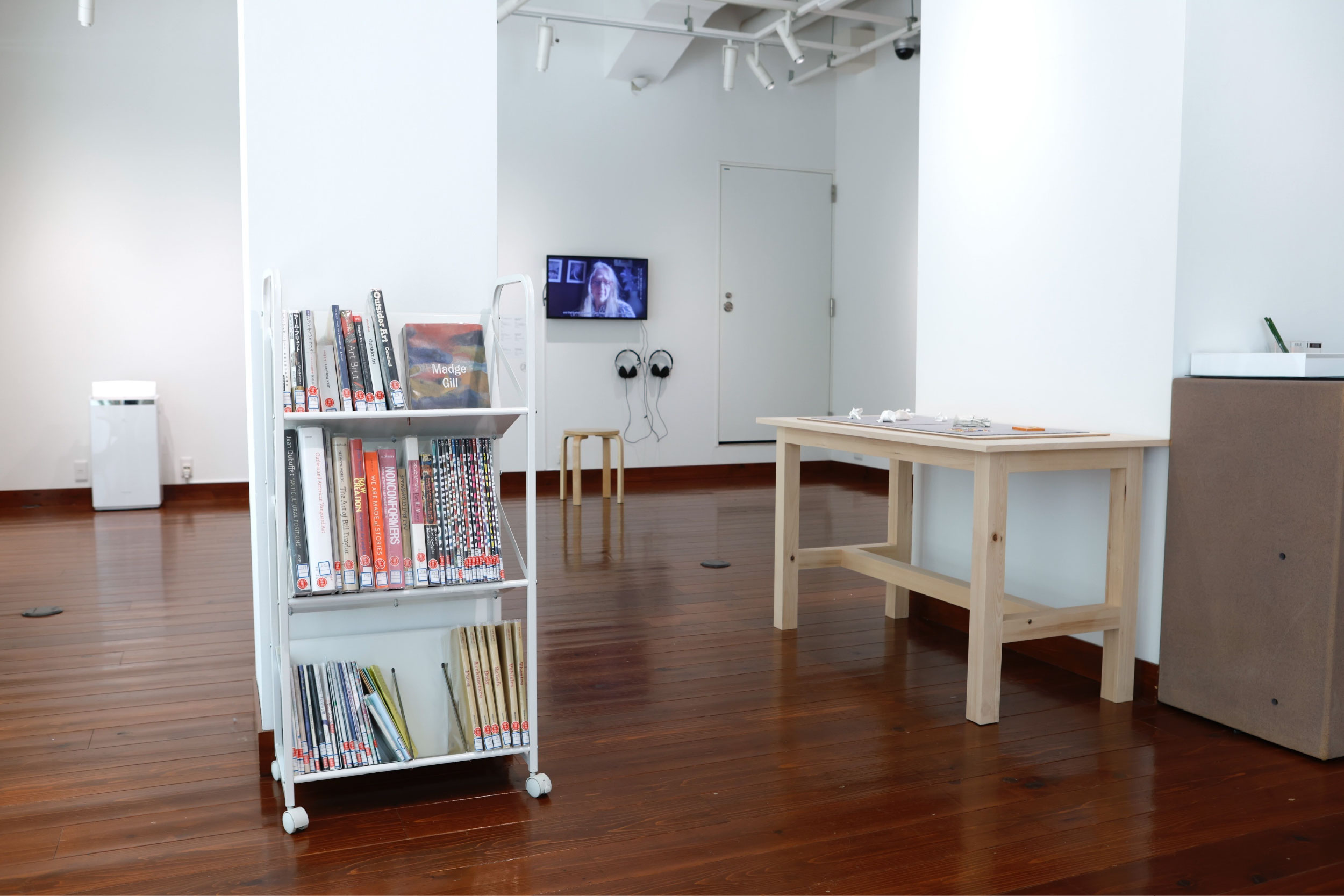
The Meeting Place of Unveiled Worlds
Reference space
- Period
- Saturday, 21 June 2025 - Sunday, 31 August 2025
- Closed
- Mondays*, 22 July, 12 August *except 21 July, 11 August
- Venue
- Tokyo Shibuya Koen-dori Gallery, Interactive Space
- Opening Hours
- 11:00AM - 7:00PM *Extended hours until 9:00PM on Fridays:15, 22, and 29 August
- Admission
- Free




